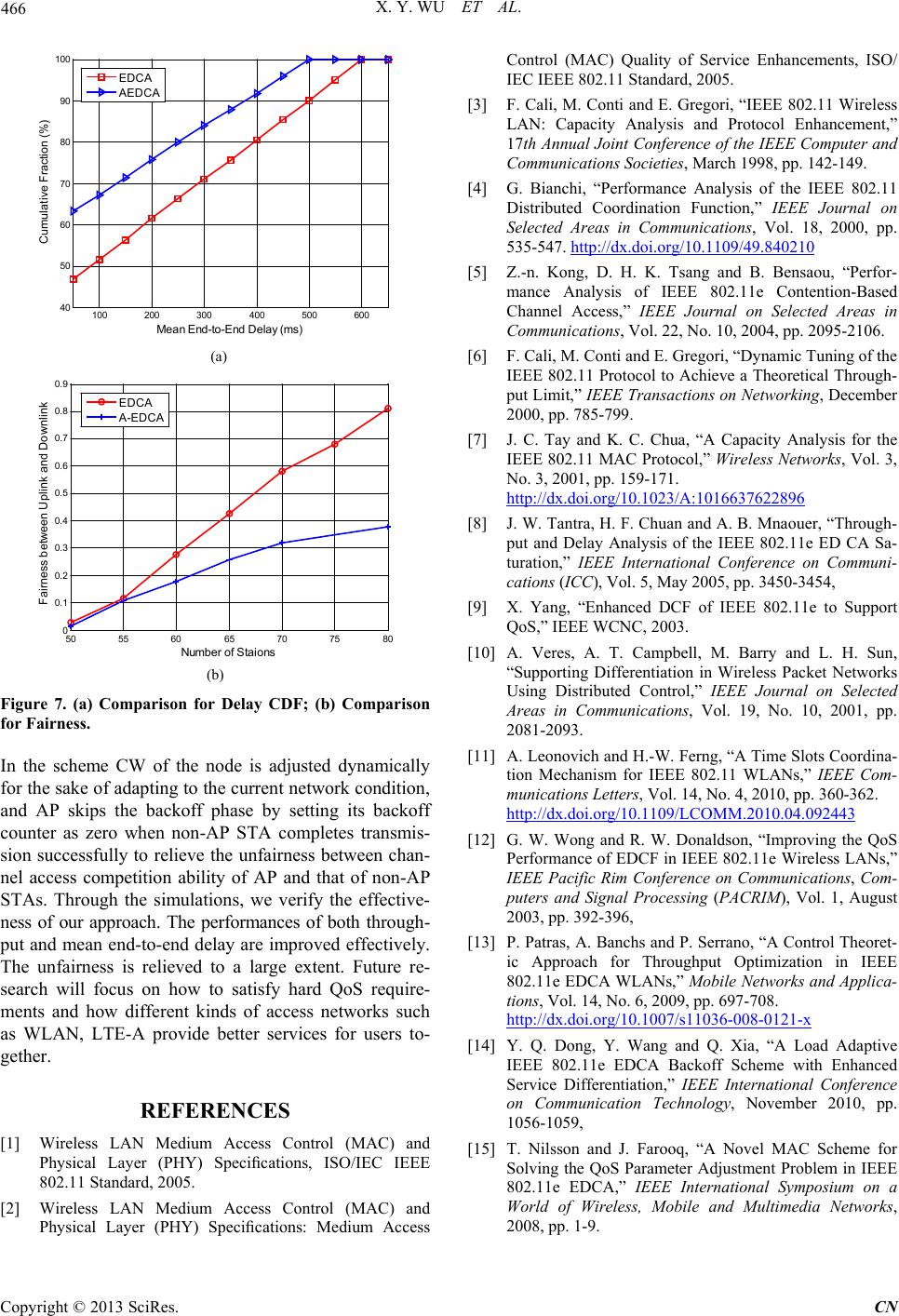
X. Y. WU ET AL.
Copyright © 2013 SciRes. CN
(a)
(b)
Figure 7. (a) Comparison for Delay CDF; (b) Comparison
for Fairness.
In the scheme CW of the node is adjusted dynamically
for the sake of adapting to the current network condition,
and AP skips the backoff phase by setting its backoff
counter as zero when non-AP STA completes transmis-
sion successfully to relieve the unfairness between chan-
nel access competition ability of AP and that of non-AP
STAs. Through the simulations, we verify the effective-
ness of our approach. The performances of both through-
put and mean end-to-end delay are improved effectively.
The unfairness is relieved to a large extent. Future re-
search will focus on how to satisfy hard QoS require-
ments and how different kinds of access networks such
as WLAN, LTE-A provide better services for users to-
gether.
REFERENCES
[1] Wireless LAN Medium Access Control (MAC) and
Physical Layer (PHY) Specifications, ISO/IEC IEEE
802.11 Standard, 2005.
[2] Wireless LAN Medium Access Control (MAC) and
Physical Layer (PHY) Specifications: Medium Access
Control (MAC) Quality of Service Enhancements, ISO/
IEC IEEE 802.11 Standard, 2005.
[3] F. Cali, M. Conti and E. Gregori, “IEEE 802.11 Wireless
LAN: Capacity Analysis and Protocol Enhancement,”
17th Annual Joint Conference of the IEEE Computer and
Communications Societies, March 1998, pp. 142-149.
[4] G. Bianchi, “Performance Analysis of the IEEE 802.11
Distributed Coordination Function,” IEEE Journal on
Selected Areas in Communications, Vol. 18, 2000, pp.
535-547. http://dx.doi.org/10.1109/49.840210
[5] Z.-n. Kong, D. H. K. Tsang and B. Bensaou, “Perfor-
mance Analysis of IEEE 802.11e Contention-Based
Channel Access,” IEEE Journal on Selected Areas in
Communications, Vol. 22, No . 10, 2004, pp. 2095-2106.
[6] F. Cali, M. Conti and E. Gregori, “Dynamic Tuning of the
IEEE 802.11 Protocol to Achieve a Theoretical Through-
put Limit,” IEEE Transactions on Networking, December
2000, pp. 785-799.
[7] J. C. Tay and K. C. Chua, “A Capacity Analysis for the
IEEE 802.11 MAC Protocol,” Wirele ss Networks, Vol. 3,
No. 3, 2001, pp. 159-171.
http://dx.doi.org/10.1023/A:1016637622896
[8] J. W. Tantra, H. F. Chuan and A. B. Mnaouer, “Through-
put and Delay Analysis of the IEEE 802.11e ED CA Sa-
turation,” IEEE International Conference on Communi-
cations (ICC), Vol. 5, May 2005, pp. 3450-3454,
[9] X. Yang, “Enhanced DCF of IEEE 802.11e to Support
QoS,” IEEE WCNC, 2003.
[10] A. Veres, A. T. Campbell, M. Barry and L. H. Sun,
“Supporting Differentiation in Wireless Packet Networks
Using Distributed Control,” IEEE Journal on Selected
Areas in Communications, Vol. 19, No. 10, 2001, pp.
2081-2093.
[11] A. Leonovich and H.-W. Ferng, “A Time Slots Coordina-
tion Mechanism for IEEE 802.11 WLANs,” IEEE Com-
munications Letters, Vol. 14, No. 4, 2010, pp. 360-362.
http://dx.doi.org/10.1109/LCOMM.2010.04.092443
[12] G. W. Wong and R. W. Donaldson, “Improving the QoS
Performance of EDCF in IEEE 802.11e Wireless LANs,”
IEEE Pacific Rim Conference on Communications, Com-
puters and Signal Processing (PACRIM), Vol. 1, August
2003, pp. 392-396,
[13] P. Patras, A. Banchs and P. Serrano, “A Control Theoret-
ic Approach for Throughput Optimization in IEEE
802.11e EDCA WLANs,” Mobile Networks and Applica-
tions, Vol. 14, No. 6, 2009, pp. 697-708.
http://dx.doi.org/10.1007/s11036-008-0121-x
[14] Y. Q. Dong, Y. Wang and Q. Xia, “A Load Adaptive
IEEE 802.11e EDCA Backoff Scheme with Enhanced
Service Differentiation,” IEEE International Conference
on Communication Technology, November 2010, pp.
1056-1059,
[15] T. Nilsson and J. Farooq, “A Novel MAC Scheme for
Solving the QoS Parameter Adjustment Problem in IEEE
802.11e EDCA,” IEEE International Symposium on a
World of Wireless, Mobile and Multimedia Networks,
2008, pp. 1 -9.
100 200 300400500 600
40
50
60
70
80
90
100
Mean End-to- End Del ay (ms)
Cumulative Fract ion (% )
EDCA
AEDCA
50 55 6065 70 7580
0
0.1
0.2
0.3
0.4
0.5
0.6
0.7
0.8
0.9
N um ber of St aions
Fairn es s be twee n Uplink a nd Downlink
EDCA
A-EDCA